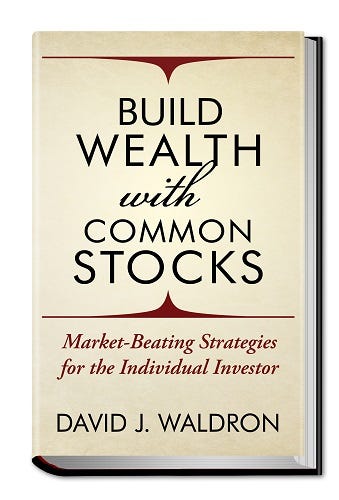Course Module 104: Dividend Value Investing
An alternative high-yield model for thoughtful investors

Summary
Defining and advocating for dividend value investing toward preserving invested capital in contrast to dividend growth and high-yield investing.
The pursuit of alpha equates to a portfolio of predominantly dividend-paying common stocks of quality companies outperforming the corresponding benchmark over time.
Chasing dividend yields and non-dividend momentum growth are recipes for junk equity.
An alternative high-yield model supported by a sustainable payout ratio, plus how disciplined value investors allocate dividends in their portfolios.
The course module concludes with voluntary action items and suggested resources.
Dividend investing is buying stocks that pay dividends to receive a regular income from our investments. The dividend income is in addition to any capital gains in our portfolios as the constituent common stocks, exchange-traded funds, or other holdings increase or decrease in value.
Dividend growth investing is a popular strategy with retail investors. It entails buying shares in companies with a record of paying regular and increasing dividends, commonly referred to as kings and aristocrats in the financial media. An added component is using the payouts to reinvest in the company’s shares—or shares of other companies with similar dividend track records.
Dividend value investing is a term coined by the author that focuses more on the company’s quality and the stock’s value than its dividend growth history. In other words, any dividends are a bonus payment in the short term while waiting for capital gains to compound over the long term.
Quality Value Investing Course Module 104 introduces an alternative yield methodology for outperforming Treasury rates without the limitations of the dividend growth strategy—such as overweighting dividend history—or the inherent risks of high-yield dividend investing.
Course Module 104 Syllabus
Subject matter objective: Defining and advocating for dividend value investing toward preserving invested capital in contrast to dividend growth and high-yield investing.
Principles of dividend value investing.
Why chasing yield is a recipe for junk equity.
An alternative high-yield dividend model.
The all-encompassing payout ratio defined.
How disciplined value investors allocate dividends in their portfolio.
Building and maintaining portfolio wealth from dividend value investing.
Module 104 voluntary action items.
Resources.
Principles of Dividend Value Investing
The quality value investing model of owning the common shares of world-class enterprises purchased at reasonable prices builds winning portfolios over time from the compounding total return of capital gains and dividends, the two best financial friends of everyday retail stock investors.
Any ongoing dividend yields are the stock market equivalent of receiving interest payments on the outstanding principal of a loan or the equivalent of the initial capital investment to purchase the shares of the stock.
The pursuit of alpha equates to a portfolio of predominantly dividend-paying common stocks of quality companies outperforming the corresponding benchmark over time, plus exceeding any other expectations of disciplined long-view investors.
Owning US exchange-traded common shares representing companies paying reasonable dividends far outweighs the risks of perceived fast money opportunities from non-dividend momentum growth stocks or high-yield dividend payers. Thus, consider keeping major exchange-traded, quality, non-dividend-paying growth stock allocation to a minimum. Quality dividend value stocks compensate us now with regular payouts and reward us later with compounding capital gains.
Target companies with a forward dividend yield or the annual dividend rate divided by the current stock price exceeding 2 percent and below 6 percent; however, consider buying the dividend-paying stock of a quality company trading at an attractive price if the historical yield is below 2 percent. Trailing dividend yield indicates how much a company paid out in dividends for the previous twelve months relative to the share price. The dividend rate is the dollar sum of dividends paid over the prior fiscal year.
Most high-yield and some dividend growth investors gravitate to dividend yields far exceeding the 10-Year Treasury rate. On the contrary, disciplined investors are cautious with dividends susceptible to erratic stock price fluctuations, unexpected rate decreases, or unsustainable payout ratios.
The dividend payout from an expensive stock equates to a dividend purchased or held at a high cost. Value and price prevail in every area of investing. Thus, practice the more balanced approach of value-based buy-and-hold total-return investing.
With 33 of the 38 holdings currently paying a dividend, the Quality Value Investing Concentrated and Expanded Portfolios, on the whole, seek long-term compounding growth of both principal and income. Achieving a sufficient current income from regular dividends is paramount to the total-return objective; therefore, with occasional exceptions, a company should pay a standard premium for the common shares to be eligible for inclusion in our portfolios.
Chasing Yield is a Recipe for Junk Equity
Chasing dividend yields and non-dividend momentum growth from equities are recipes for junk. Instead, build wealth with total-return investing—capital gains plus income—thus, in retirement, we pursue bucket list items instead of desperately seeking higher dividend payouts.
Quality-based value investing focuses on dividend yields below 6 percent, a range where we find superior companies paying far lower than 100 percent of earnings in dividends, also referred to as the payout ratio, addressed further later in this module. Many companies behind 6 to 10 percent and higher-yielding shares must grow dividend rates, or the stocks need to fall in price, or a combination thereof, for the dividend yields to remain high or increase. Those are recipes for destroying invested capital.
High-yield dividend stocks were top-of-mind for investors starving for higher payouts in the low-interest-rate environment of the post-Great Recession bull market. As a result, many top subscription offerings and financial media pieces focused on the high-yield paradigm. Unfortunately, history tells us the crowd is almost always wrong regarding fads and favorites. High-yield dividend stocks are no exception, so disciplined investors should maintain a skeptical view of the practice.
Along with elevated income returns, loom risky headwinds and questionable underlying fundamentals. Just ask the victims of the high-yield junk bond bubble in the 1980s. History also reminds us of how that bubble burst during the stock market crash of 1987. The junk bond craze returned to the recent bull market through high-yield dividend stocks. This time, instead of leveraging mergers and acquisitions at the corporate level when available capital was insufficient, high-yield equities influenced daring risk/reward plays as retail investors and advisors sought outsized returns to leverage underfunded retirement account balances.
An inevitable cyclical downturn in the overall stock market preempts the principal capital invested by millions of retail investors concentrated in risky, high-yield dividend equities such as business development companies (BDCs), master limited partnerships (MLPs), closed-end mutual funds (CEFs), real estate investment trusts (REITs), as well as energy transfer partnerships and preferred stocks.
Thoughtful investors never buy stocks based on market euphoria or the dividend yield alone. However, some well-crafted story headlines and marketing pitches cast a positive spin on the paradox of a safe, high-yielder. Unfortunately, such absurdity is akin to fishing for sushi-grade salmon in a crystal clear river known as toxic from a colorless pollutant.
These pundits remind us of what we missed, disregarded, and tripped over in our retail-level analysis, challenging our assumptions and conclusions. Although the professional debate is encouraged and welcome, the thesis remains that investors are chasing the dividend more than enterprise quality with high-yield stocks. Nonetheless, if a conscientious trading strategy puts income ahead of capital gains, so be it with cautionary best wishes.
Remember, dividend rates adjust monthly, quarterly, or annually from board-directed payouts; as the corresponding yields go up and down each market day as a prisoner of the stock price. The concept of dividend payouts involves a simple paradigm in the fundamental economics of the price/yield relationship, whether bonds or equities. The yield goes down when the price goes up, and vice versa.
The enticement of high-yielding stocks seems to overshadow the necessary due diligence to determine if the representative company is stable enough to justify the yield with capital allocations and shareholder returns from a well-managed operation. For example, do we prefer to own a quality 4 percent yielder with compounding average capital gains of 6 percent a year or a high-risk stock yielding 10 percent, although averaging a minus 5 percent annualized capital loss?
In the former example, value investors are averaging a plus 10 percent annual total gain. In contrast, high-yield fans settled for a meager plus 5 percent average annual total return.
Perhaps some retirees have had the opposite experience by investing in high-yielders producing double-digit total returns each year during the recent bull market. But, like a raucous party, this bubble burst when the coronavirus pandemic arrived uninvited, followed by the 2022-23 inflationary bear market. And high dividend investors who think it’s possible to time the perfect exit are sailing on the proverbial ship of fools.
However, there is an anecdote. Course Module 104 continues with an alternative high-yield dividend model and how successful value investors employ it to allocate safer income streams in their portfolios.
Let’s first read the required disclosures and background information.
Disclosure: As of the date of this post, I/we had beneficial long positions in the shares of all the stocks represented in the QVI Concentrated Portfolio through direct stock ownership in our family portfolio. I wrote this article myself, and it expresses my own opinions. I am not receiving compensation for it (other than from Substack paid subscriptions). I have no business relationship with any company whose stock is mentioned in this article.
Additional disclosure: Quality Value Investing by David J. Waldron’s course modules are for informational purposes only. The accuracy of the data cannot be guaranteed. Narrative and analytics are impersonal, i.e., not tailored to individual needs nor intended for portfolio construction beyond his family portfolio, which is presented solely for educational purposes. David is an individual investor and author, not an investment adviser. Readers should always engage in their own research or due diligence and consider (as appropriate) consulting a fee-only certified financial planner, licensed discount broker/dealer, flat fee registered investment adviser, certified public accountant, or specialized attorney before making any investment, income tax, or estate planning decisions.
About the Writer
David J. Waldron is contributing editor of Quality Value Investing and author of the international-selling book, Build Wealth with Common Stocks: Market-Beating Strategies for the Individual Investor. David’s mission is to inspire the achievement of his readers’ financial goals and dreams. He received a Bachelor of Science in business studies as a Garden State Scholar at Stockton University and completed The Practice of Management Program at Brown University. David and his wife, Suzan, reside in historic South Central Pennsylvania, USA.
Preview David’s Book
Readers can preview Build Wealth with Common Stocks here: https://davidjwaldron.com/build-wealth-with-common-stocks.html, including links to over 25 booksellers worldwide.
Bonus: Founding Members of QVI on Substack receive a personalized complimentary copy of the case laminate hardcover edition of the book from the author.






